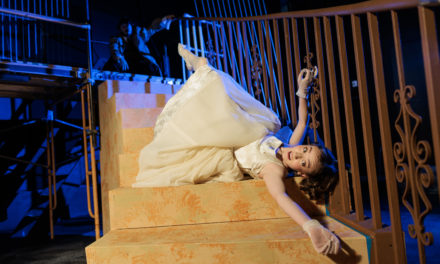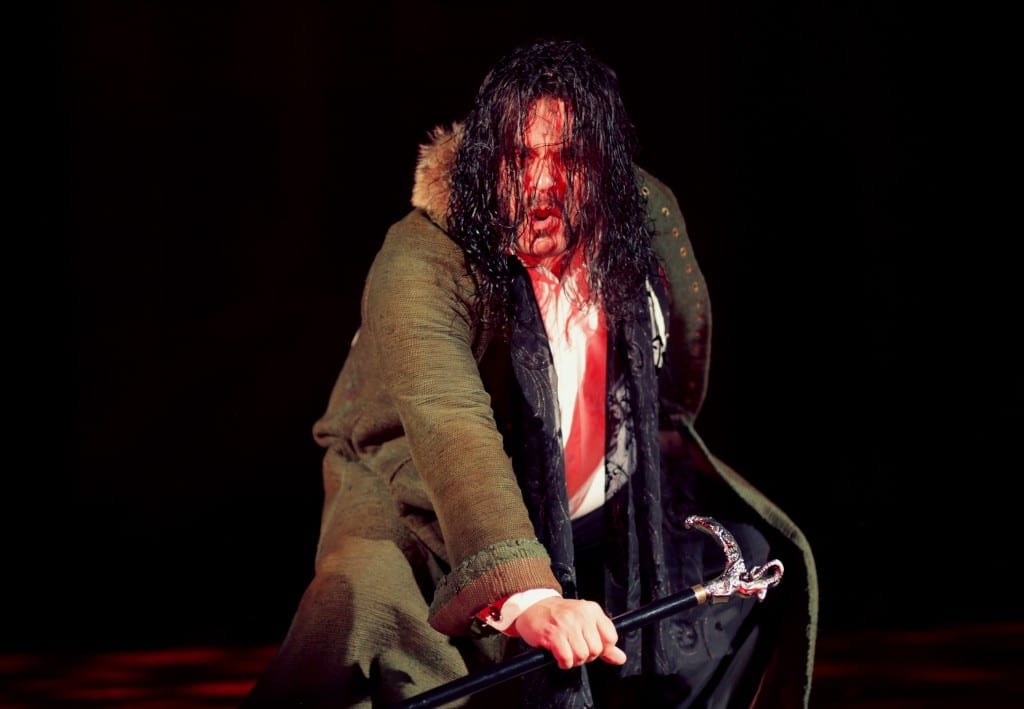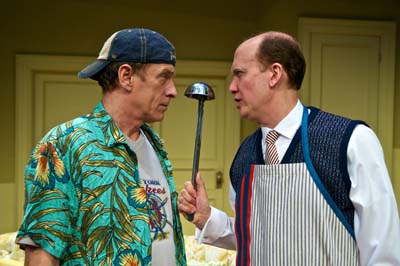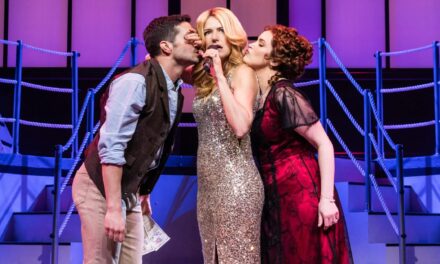
Show closes October 14, 2017.
WEST VALLEY CITY — I’ve written before about the Hale Centre Theatre brand and how it often translates into a penchant for repetition in their programming choices. Despite this —or rather, because of it— HCT makes great efforts to bring new properties to Utah whenever they can. Almost any new Broadway show (or near-Broadway miss) that fits the Hale profile can be expected to grace their stage within a few years. So I give them credit for doing their best to introduce their audiences to new material, whatever my thoughts on the material itself. Looking ahead to the next year, you’ll find Tuck Everlasting, Newsies, and The Hunchback of Notre Dame on the schedule, all of which had their Broadway (or, in the case of the last one, high-profile regional) premieres within the last five years. However, this is a double-edged sword. After all, for every Peter and the Starcatcher, there is a Ghost: The Musical.
The Heart of Robin Hood is another such recent endeavor. Written by the associate director of the Royal Shakespeare Company, David Farr (based on his novel of the same name), it debuted in an RSC production at the end of 2011. It has played a few regional theaters in the United States (Oregon Shakespeare Festival, American Repertory Theater), but a pre-Broadway run in Toronto never made it to New York. Part Peter and the Starcatcher, part Spamalot, part Shakespeare, both an origin story (a comparison the director’s notes invite) and a revisionist retelling, The Heart of Robin Hood encompasses a tonal palette from dark to very silly, and even manages to be gruesome at both ends of that spectrum. As you might expect, the HCT production, directed by Dave Tinney, keeps up Hale standards of acting, design, and production values. Be ye forewarned, though: whatever surprises await the audience in Farr’s version of the Robin Hood legend, by far the most unexpected aspect of this staging is that director Tinney, in collaboration with Rob Moffat, has transformed The Heart of Robin Hood into a full-fledged musical.
Story-wise, the most prominent departure from convention is that Marion (played by Riley Branning) is now the protagonist — read into that what you will vis-à-vis the title. Determined to avoid a marriage to the king’s brother, the evil regent Prince John (Benjamin J. Henderson), she escapes to the forest with her servant, Pierre (Daniel Fenton Anderson), to join Robin Hood (Derek Smith) and his Merry Men. When they meet, however, Marion is disillusioned to discover a self-interested and amoral Robin instead of the altruistic robber she expected. So, Marion reimagines herself as “Martin of Sherwood,” rechristens Pierre as “Big Peter,” and sets out to give the country the noble outlaw it needs — someone to protect the defenseless and, of course, “steal from the rich and give to the poor.” Eventually, Martin and Robin are forced into an uneasy alliance to resist the treachery of Prince John, leading to predictable results, as far as the two outlaws are concerned.
The understated set, by Kacey Udy, consists of a circular platform with two winding stairway entrances and a ring of various drapes above the stage to suggest a forest canopy. I enjoyed the scenic restraint: nothing rotates, sinks, rises, or comes down from the flies. I also loved Peggy Willis’s costume designs: an assortment of pieces both contemporary and period, often with elements of the former (like scarves, hoodies, or Doc Martens) arranged in such a way so as to evoke the latter. One conspicuous exception is Marion’s disguise as Martin. Her green and brown leather attire bears no obvious modern day traces and cuts a more traditional Robin Hood figure than Robin himself, perhaps as a reflection of her idealism and belief in what she is doing. Prince John’s costume, on the other hand, veers in the other direction. Arrayed in a smoking jacket, tailored pants, dress shirt, and cufflinks, with eyeliner, a shock of dyed blond hair, and a handkerchief almost always hooked in his fingers, he exudes a sinister materialism.
Speaking of Prince John, I remember Henderson fondly as Kodaly in the transcendent Dave Tinney-directed She Loves Me from 2014. Tinney was wise to cast him again as a villain, for Henderson elevates the king’s brother to the stardom he longs for. I found myself grinning at his line readings every time he spoke. Both dynamic and nonchalant in his malevolence, he brilliantly channels a sadistic fusion of Percival Blakeney, Jack Sparrow, and Cruella De Vil. Branning sparkles with intensity as the shakespearean cross-dressing Marion. She plays easily off of Anderson, who imbues Pierre with a charming, artless earnestness. Smith makes about as much as he can of Robin, but his character is woefully underwritten. When he professes his change of heart, I couldn’t help but feel that I knew his old self by reputation only. Among the supporting roles, Zöe Wilde made many interesting choices in the deceptively difficult part of Marion’s sister, Alice. I was amused to see that every time Bryan Dayley entered the stage, it was either to be robbed or play a different clergyman, sometimes both at once. And I was almost unsettled by how much I believed in Alyssa Buckner’s distress during the execution scene.
As I mentioned earlier, Hale has transformed The Heart of Robin Hood into a musical, despite the fact that all previous productions (and a subsequent one later this year in California with the original director) have been nothing of the kind. HCT’s website also makes no mention of this detail, so if you had seen or heard of this show before, you would have no way of knowing what you were getting yourself into until you opened the program to see “original songs by” Tinney and Moffat prominently displayed under the playwright’s name. I applaud HCT for being willing to take a risk on doing something like this, but I wish I were more enthusiastic about the results.
The songs cover a range of styles, from pop anthems to period-inflected ballads. Conceptually, I can understand this approach, given the tonal shifts in the script and the pastiche on display. Nevertheless, there’s a fine line between eclectic coherence and a hodgepodge, and the score doesn’t quite manage to walk it. Perhaps it’s because the songs, which weren’t conceived in collaboration with the playwright (I presume), aren’t as organically integrated into the book as they ought to be. Or maybe it’s due to the fact that, for example, a single scene can contain much of the script’s variety, just as a single costume can reflect a complementary mix of styles to some degree. Yet, many of the individual songs each tend to fit into different categories altogether. The most prominent issue, however, is that the songs add an extra, overly sentimental dimension to the proceedings that makes the show’s tonal variability harder to navigate. As a result, in the aggregate, the songs work against the aesthetic unity of the whole.
For example, Robin’s first number, “If I Want It,” reminded me of a theme from a Saturday morning cartoon from the 80s (this is more apparent when it’s used as an underscore). I don’t say that with malice because, by itself, I don’t consider it a criticism. I can even see how, in theory, the songwriters might have intended this to provide insight into Robin’s immature character. But it also conjures up facile notions of heroism and simplistic distinctions between good guys and bad guys. This doesn’t match the shades of grey we’re supposed to see in Robin and chafes against the genuinely darker moments still to come.
From a songwriting standpoint, there were elements I admired, like the lullaby refrain in “Eden’s Grove.” But I found the majority of the lyrics unremarkable and almost every song strained the limits of the actors’ vocal ranges, despite the cast boasting some accomplished singers. Even when this wasn’t an issue, rarely did the music sit comfortably in the performers’ voices. Neither seemed to do the other justice. Moreover, in the upbeat numbers, it often felt like the singers were just barely keeping up with the tempo and putting a lot of effort into getting the lyrics out on time. The recorded accompaniment also sometimes leaned heavy on the mid-range frequencies, which impeded intelligibility.
The bottom line is that, for a musical to justify being a musical, its dramatic and aesthetic high points must be the songs. I regret to say that this isn’t the case in The Heart of Robin Hood. Nevertheless, as I said before, I am glad to see Hale put its considerable resources behind attempting something as risky as producing what is essentially an original musical (and impressed they talked the playwright into letting them do it). As HCT moves to its new, state-of-the-art facility in Sandy, I hope having two stages will embolden them to take even more such risks in the future.






